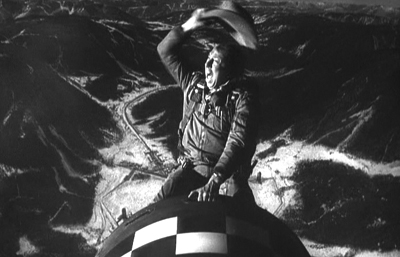The 5 Scariest Nuclear Accidents
Apr 5th, 2010, 10:57 am
Recommended Videos
The National Security Archive blog, dedicated to “informing the public debate through access to declassified documents,” has a harrowing post up about a Department of Defense report on military accidents while handling nuclear weapons.
Turns out there were 32… before 1980.
NSArchive lists the ones that have most closely flirted with disaster, and they read like something from a Peter Sellers movie:
- In 1957 a nuclear bomb fell through the bomb bay doors of a B-36 bomber near Kirkland Air Force Base, New Mexico. The bomb fell 1,700 feet to the ground and its high explosives detonated, showering fragments as far as one mile from the impact point.
- In 1958 a B-47 “accidentally jettisoned an unarmed nuclear weapon” which fell and detonated on a garden owned by the Gregg family in Mars Bluff, South Carolina. The high explosive detonation created a crater 50-70 feet wide and 25-30 feet deep. The Gregg family’s home was completely destroyed (the DOD report recounted only “property damage”); five other homes and a church were also damaged. Fortunately, members of the Gregg family received only minor injuries.
- In 1960 a 47-foot-long BOMARC air defense missile (which could be readied to launch within minutes) caught fire at McGuire Air Force Base near Trenton, New Jersey. According to the New York Times, the missile “melted under an intense blaze fed by its 100-pound detonator of TNT… The atomic warhead apparently dropped into the molten mass that was left of the missile, which burned for forty-five minutes.” The DOD report was less descriptive, stating merely that “nuclear safety devices acted as designed.”
- In 1961 a B-52 carrying two 24 megaton nuclear weapons (equivalent to 3,700 “Hiroshima bombs”) broke up in the air over Goldsboro, North Carolina. One bomb fell as far as 10,000 feet and sunk into the “waterlogged farmland.” The Air Force dug as deep as 50 feet trying to excavate the weapon, which contained uranium, but was unsuccessful. Finally, the Air Force purchased an easement on the land. Reportedly, a Pentagon document stated that five of the bomb’s six safety mechanisms had failed; “only a single switch” prevented the nuclear detonation of this 24 megaton device.
- In 1966 a B-52 carrying four nuclear weapons crashed into a KC-135 aircraft over Palomares, Spain. Two of the bombs did not explode and were eventually recovered after a search described as “the most expensive, intensive, harrowing and feverish underwater search for a man-made object in world history.“ Two of the bombs’ high explosive material exploded on impact with the ground. The explosion –though conventional– released substantial amounts of radioactive materials. 1400 tons of soil and vegetation were eventually removed and transported to the United States.
The entire article, including links to declassified documents from the Department of Defense and The Defense Monitor, can be found here.
(via /.)
Have a tip we should know? [email protected]
